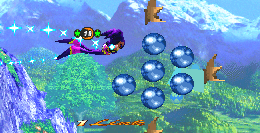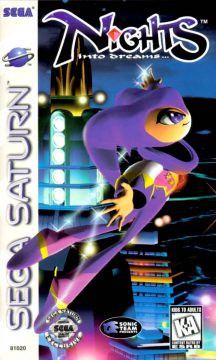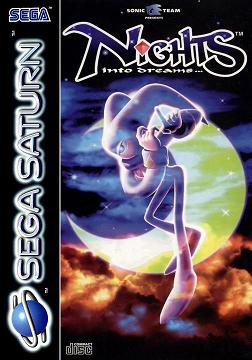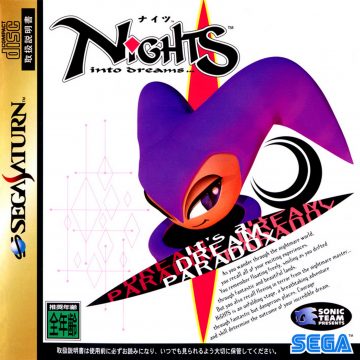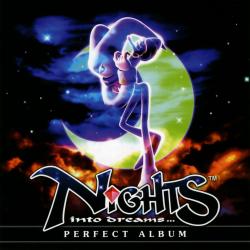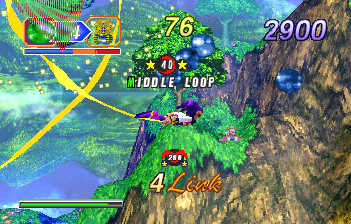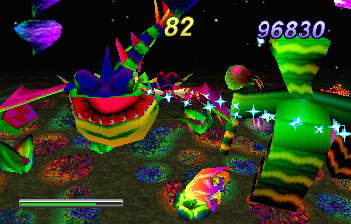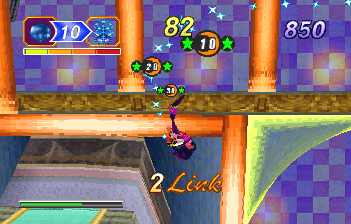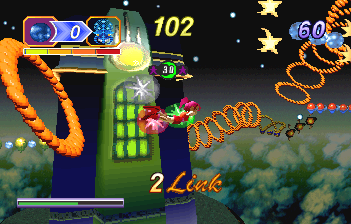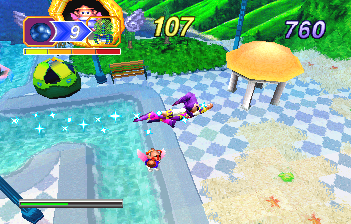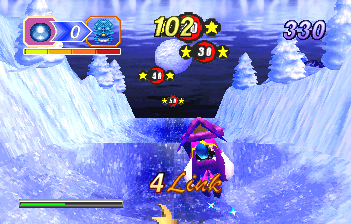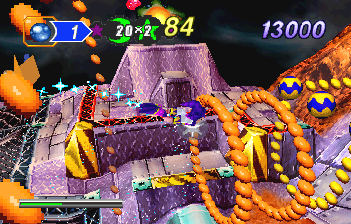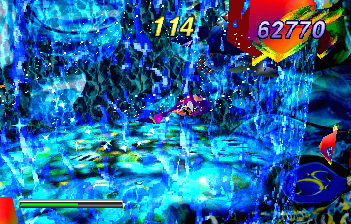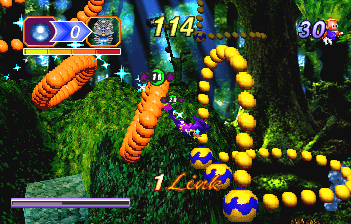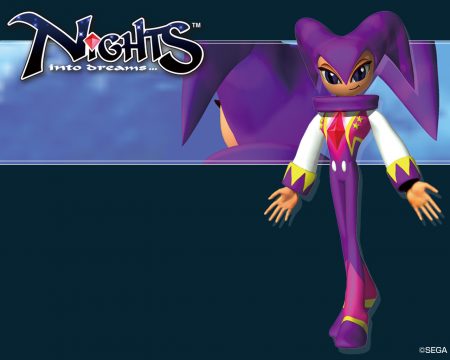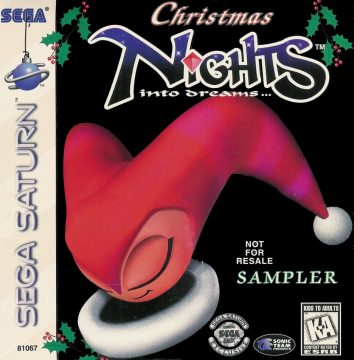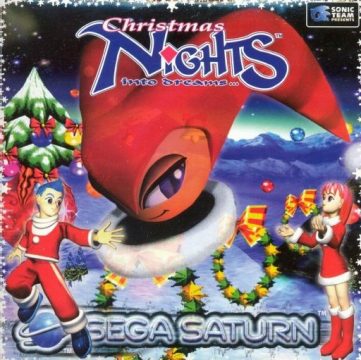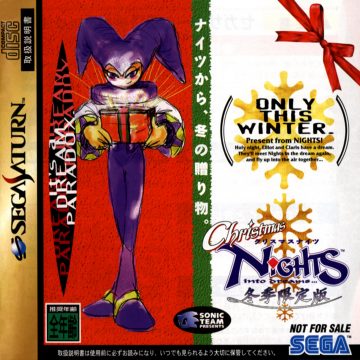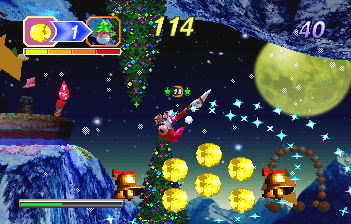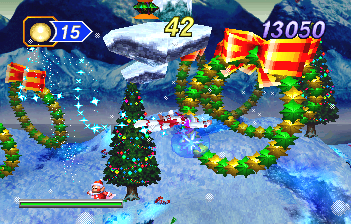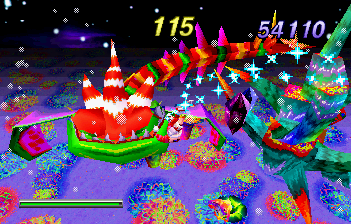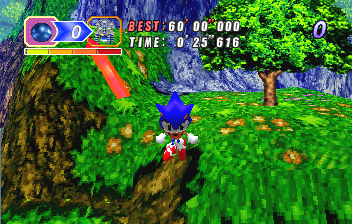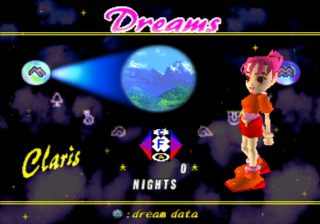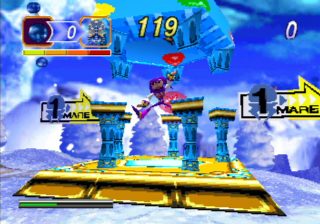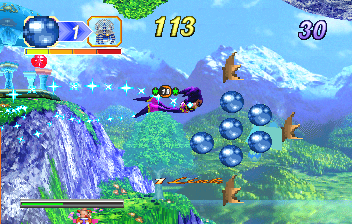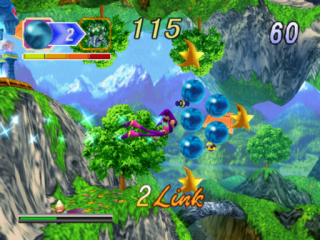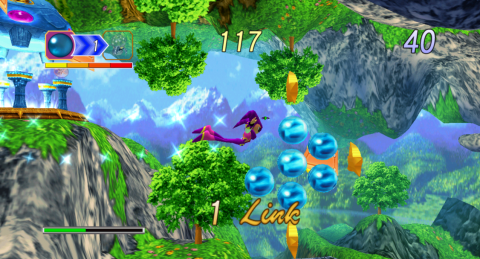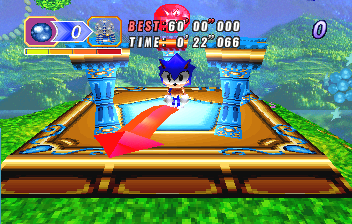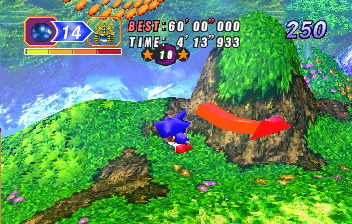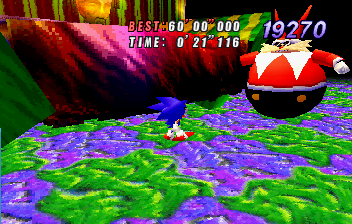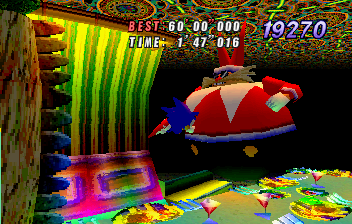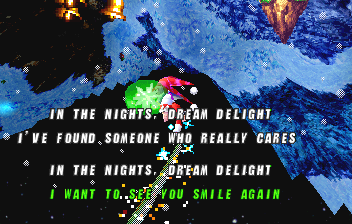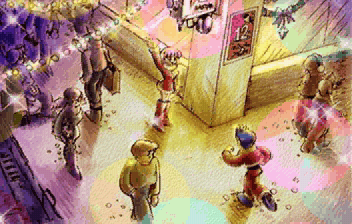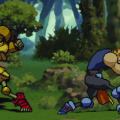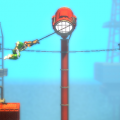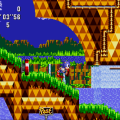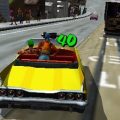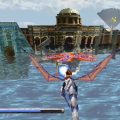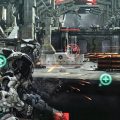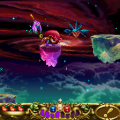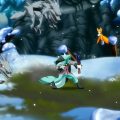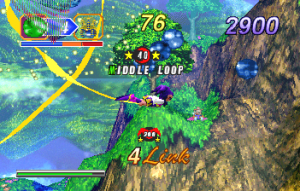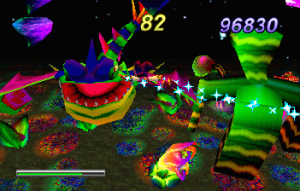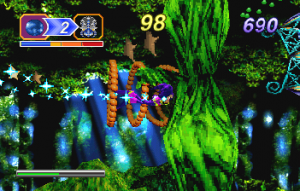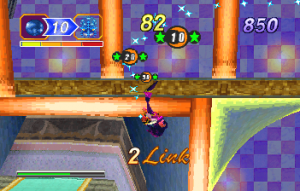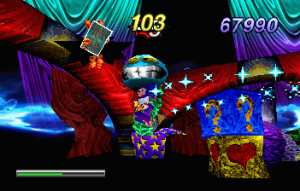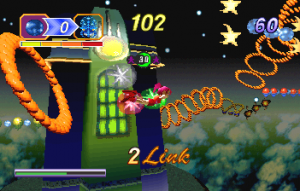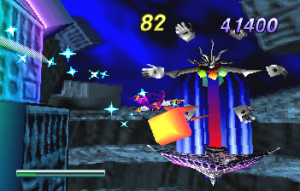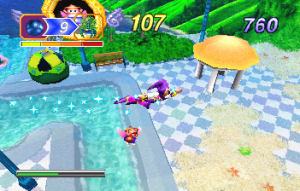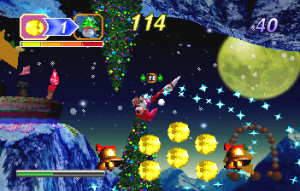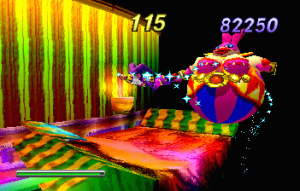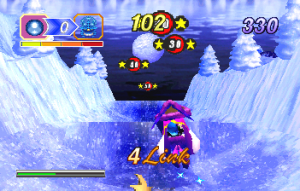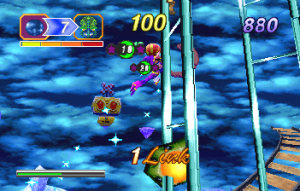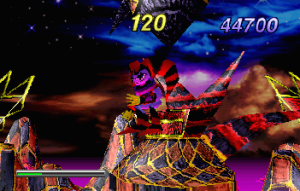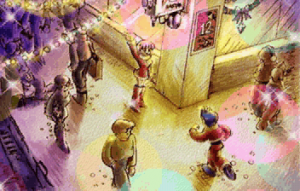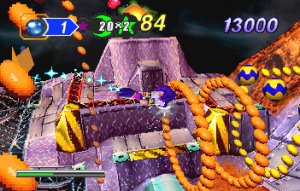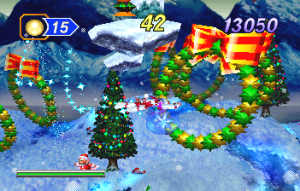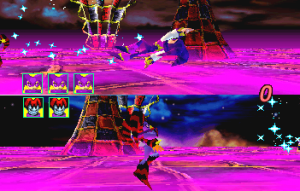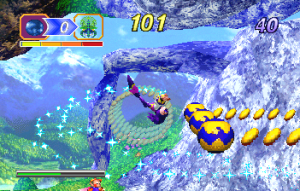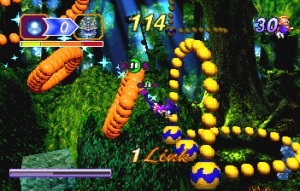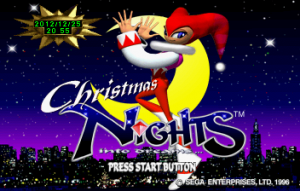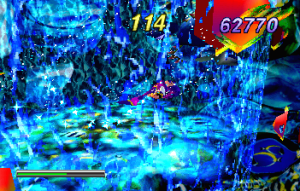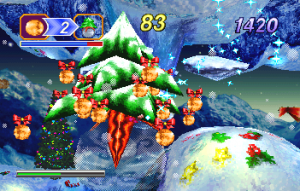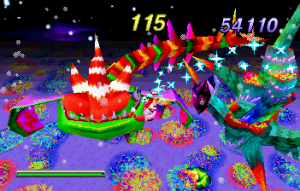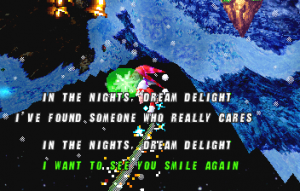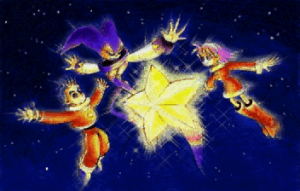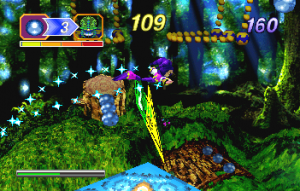- NiGHTS into Dreams…
- NiGHTS: Journey of Dreams
Sega’s approach to the Saturn was somewhat baffling, to say the least. In America and Europe, the Genesis stood its ground against the SNES largely thanks to the likes of Sonic the Hedgehog. As the 16-bit era was winding down and the 32-bit era was winding up, it would’ve made sense to pimp the mascot character as much as possible. That didn’t happen – instead, Sonic Team developed NiGHTS…Into Dreams, which, for better and for worse, was something entirely different.
The story focuses on two young children named Claris Sinclair and Eliott Edwards, both from the town of Twin Seeds. During the course of their days they endure humiliating failures – Eliott is picked on during a game of basketball, while Claire flubs a musical audition – but at night they dream of a land known as Nightopia. It suffers from the tyrannical rule of Wizeman the Wicked, who is challenged by Nights, a purple jester, and of course, hero of the game. Nights has been imprisoned, but Claris and Eliott both possess the Red Ideya of Courage – in other words, they have the power to free Nights from his bonds, and they all work together to destroy Wizeman.
There’s absolutely none of this actually mentioned in-game, beyond the dated, pixelated CG scenes that imply the story. It’s a testament to how closely NiGHTS feels to Sega’s arcade roots, which was becoming increasingly unusual in 1996. Furthermore, most mascot games were typically platformers, but if you were to try to stick NiGHTS into a pre-defined genre, it would be closest to a racing game. Even then it’s entirely unlike anything out there – it’s more of an acrobatics game, using 3D graphics but set along a 2D plane.
There are seven stages in total – three as Eliott (Splash Garden, Frozen Bell, and Stick Canyon), three as Claris (Spring Valley, Mystic Forest, and Soft Museum), and a final stage (Twin Seeds) which is identical as both characters, though the only time where the two children actually interact with each other. When you begin a stage, you take on the role of Claris or Eliott. You’re given the option to freely run around, but this isn’t actually what you’re supposed to do. Instead, you’re meant to follow the arrow that leads to the Ideya Palace, where you can rescue (and then play as) Nights. From here, you can no longer explore freely – instead, Nights flies around a predetermined path, which loops around various parts of the stage. You can fly up and down or backwards and forwards, but not inwards or outwards.
Each stage is comprised of four “Mares”, or paths. When you start each Mare, you have 120 seconds to gather 20 blue-colored chips, place them in the Ideya Cage located in the middle of the stage, and return to the palace at the beginning of the Mare. This is rarely very difficult, as there’s more than enough time to gather everything, but instead the emphasis is placed heavily on scoring. As you pick up objects, you’ll build up combos called “links”, which increase the point value as you pick up more objects in unison. There are also rings you can fly through, which restore your “dash” power, along with adding to your link. Additionally, if you perform a loop-de-loop (called a “paraloop”), it’ll create a small vortex which will automatically gather all the items in the area, including those that are normally out of reach.
Once you gather 20 chips and deliver them to the Ideya Cage, you’ll enter “Bonus Time”, which doubles all of the point values. All of the chips and rings reset as you finish a loop around each Mare, giving you an opportunity to grab them again and again. Ultimately, the goal of each Mare is to gather up the orbs and enter Bonus Time as soon as possible, then spend the rest of the time repeatedly flying through the course, doing tricks and building up links, racking up as high a score as possible and reaching the Ideya Palace before time runs out.
At first, however, the mere act of playing the game is disorienting. The camera moves along a 2D plane in a 3D world, and its rails often switch in and out of the scenery, changing direction without notice. You can’t see very far ahead in any direction, and most levels have a large vertical space, too, making it easy to miss parts of the scenery. Many stages also have areas where the view changes completely, switching to an overhead perspective, or putting you in “roller coaster”-type situations where you’re automatically propelled forward. It’s remarkably confusing, and the first time you play a stage will feel like stumbling around in the dark.
There’s also a certain brilliance to the game, though. Upon repeated plays, you learn where the perspectives shift and where the camera moves. You learn the placement of all of the orbs and rings, and figure out the most efficient ways to build the highest links. In time, a confusing, perplexing mess of a game becomes an incredibly addictive challenge to perfect the controls, nail the maneuvers, and completely master each stage. In spite of its kid-friendly veneer, NiGHTS is really a hardcore time-attack game that caters to the competitive gamer.
Once you’ve completed all four Mares, you face off against the level boss. Rather than a sprawling stage, most of these take place in a confined arena. Like the main stages, you’re given 120 seconds to beat them, but there are no chips or rings. Instead, each boss has a unique method in which they must be defeated. Unfortunately, despite how brilliant it is in other areas, this is where NiGHTS kind of stumbles. There’s no real guidance provided on how to beat any of the bosses, so you need to figure it out quickly. It’s fairly obvious for some, like Gillwing, a gigantic dragon with a spiked tail – you just to need to grab its mouth and then slam it into the ground repeatedly. Others aren’t so obvious – Clawz constantly bounces around, just eluding reach by flinging himself off of candles strewn through the arena. It’s never even hinted that you’re supposed to destroy the candles until he has nowhere to go. If these encounters weren’t timed and you had the ability to experiment, this wouldn’t be an issue…but this is not the case.
It doesn’t help that the camera is often completely counterintuitive, making it very difficult to judge depth, and the hit detection is often suspect as well. The worst of this is an early boss encounter against a bounding creature called Puffy. In one of the few boss battles that takes place in a long, linear path, the goal is to grab and throw her, so she bounces off the floor and ceiling and through the breakable parts of the scenery. This would be easy, but the camera is almost never in a position where you can actually see where you’re throwing. There’s no way to replenish your dash meter if you run out, which can potentially mess up the entire battle. It’s also far too easy to get hit, which shaves five precious seconds off the clock. Running out of time not only means losing to the boss, but you fail and must replay the entire level.
The boss battles are also frustrating tonal mismatches against the rest of the game. While there are enemies and spiked rings in the stages (which also shave off a bit of time), the whole experience is otherwise non-confrontational, which is remarkably refreshing. These encounters feel like a leftover of video game conventions, which NiGHTS really didn’t need to take part in.
Regardless, at the end of each level, your performance on each Mare is added together and averaged, with a multiplier applied based on how quickly you defeated the boss. Technically you can do the bare minimum without going through all of the Bonus Time scoring stuff, but you’ll get a low ranking on the Mare. You can proceed through the levels as long as you beat the boss, but you’re only allowed into the final stage if you’ve obtained a “C” grade at a minimum on all levels.
Visually, NiGHTS is incredible. Yes, the cutscenes appear dated, and it suffers from the same pixelated, chunky look as practically every Saturn game (or any 3D game of the 32-bit era, really). Plus there’s fairly substantial draw-in, as bits of scenery fade in and out as you round corners. It’s a testament to the game’s bright colors, imaginative designs, and blazing speeds, though, that its visual shortcomings are all barely noticeable, leading to a product that’s still aesthetically gorgeous. It’s also the best looking game on the Saturn.
The music, too, is upbeat, and almost impossibly joy-inspiring. It has a bouncy, dream-like quality, with chimes, trumpets and harmonicas – every instrument that could encapsulate the emotions of carelessly cavorting through the skies, and nearly all of it is brilliant. The main theme is “Dreams Dreams”, a cutesy vocal theme sung in English, with a few variations sung by different actors, both children and adult. The soundtrack was supplied by Naofumi Hataya (Golden Axe II, Sonic CD JP/EU), Tomoko Sasaki (Ristar, the Burning Rangers theme) and Fumie Kumatani (her first work with Sonic Team).
The soundtrack also ties in with the most obscure element in NiGHTS – the A-LIFE system. Throughout each stage are strange, friendly creatures called Nightopians. After hatching them from eggs, you can carry them around the level or mate them with other creatures. You can even merge them with enemies, creating mutants called Mepians. If you feel like being a jerk, you can throw them around. From a scoring standpoint, this affects absolutely nothing, but it does alter the general “mood” of the level. If the Nightopians are happy, sections of the theme music change to reflect this; piss them off and the music in turn becomes darker. There are four different versions of each song (with the alternate versions known as “Sweet”, “Bitter”, and “Spicy” on the soundtrack notes), and these don’t simply change instruments or rearrange pieces of the track – they’re almost entirely different from each other. It’s sort of weird that Sega put all of this effort into something completely optional, as there’s a good chance that most people haven’t even heard a good chunk of the game’s alternate soundtracks, but it’s a nice touch.
Beyond its mechanics, NiGHTS perfectly exemplifies the “blue sky” element of the best of Sega’s games. Zooming through gorgeously detailed stages, twirling, swerving, and looping weightlessly, performing daredevil acrobatics with almost incredible ease – NiGHTS is one of those rare games that’s incredibly fun to just sit back and play, regardless of any greater goals.
The stages themselves are also brilliantly designed. Though the areas where the camera changes to an overhead perspective are disorienting, others are incredibly creative, like a section where orbs and rings only appear in a mirror in the background, requiring you to look at the reflection to fly through them. There’s also an area where you get magnetized, causing all items to become stuck to Nights. The final area, as well, is a thing of beauty. You start off by trying to rescue Nights from his cage as normal, but instead get propelled onto an isolated floating platform. With nowhere else to go, you take a leap of faith off the edge, but fly off into the sky before hitting the ground, able to zoom through the sky without Nights’ help. The rest of the stage is played as the child, though since the timer doesn’t reset after completing a Mare, it’s structured a little differently.
There’s also a two-player mode, with the screen divided in half, and the second player taking on the role of Nights’ nemesis Reala, a more sinister looking red-striped jester. The goal is to damage each other by paralooping. It’s really little more than a clumsy and short-lived diversion, though.
While loved by most Saturn fans, NiGHTS never really caught on, and hardly had an effect on the system in the same way that Sonic did on the Genesis. In spite of the game’s massively original brilliance, there are numerous reasons for this.
As a marketable character, Nights is problematic. With Sonic, Sega captured the essence of what an adolescent thought was cool. He’s fast! He’s got an attitude! Nights, on the other hand, is an androgynous, purple, flying jester in tights. The character is appealing to younger children, and even adults that still have a sense of wonderment, but to the primary game playing audience of the time – post-adolescent males – Nights was practically anti-cool.
Image aside, the actual gameplay is incredibly confusing. There are absolutely no instructions in-game, nor any tutorials, which should have been added for something so drastically different from anything else out there. Starting each stage off as the child rather than Nights was a bad idea, as well. It gives the impression that you’re supposed to explore the stage as them, which is not only the opposite of what you should be doing, but also incredibly un-fun, which leads to a terrible first impression. Even describing the basic nature of the game is difficult, since it’s full of mildly obtuse concepts and strange jargon.
The idea of repeatedly replaying stages to gain high scores was also not compatible with the types of games being made at the time. With the advent of memory cards, games in the 32-bit era became more longform, requiring many hours to complete. Technically you can play through all of NiGHTS within an hour or so, leaving it depressingly short if you don’t pay attention to the scoring aspect. This doesn’t in any way mean that the central conceit of NiGHTS is flawed, because it absolutely isn’t. It requires the player to dig deep to understand how to enjoy it, though, which was maybe the wrong thing to do with a game that’s supposed to have mainstream appeal.
Christmas NiGHTS – Saturn (1996)
Sega did attempt to market the game, however, which resulted in Christmas NiGHTS, possibly the fanciest demo for any video game ever produced (distributed as a standalone release in Japan and free with magazines in North America and Europe). As its core, it’s technically just the first level of the game (Spring Valley), with its associated boss battle, but it’s absolutely loaded with bonus content, most of which isn’t in the full game. You can play as either Claris or Eliott, though Eliott can’t normally play this level, and his course is slightly different.
The biggest addition, of course, is the Christmas-themed makeover. If you set the internal Saturn clock to winter, the level becomes dark, the land and mountains are covered in snow, and the music changes to a variation of Jingle Bells. The Nightopians are dressed as elves, the Ideya Palaces have Christmas trees on top, and the rings are now wreathes. As you get closer to Christmas, the characters even wear Santa Claus outfits. The time of day you play also influences minor aspects in the level. The story is that Gillwing has stolen the star off the town’s Christmas tree, so Claris, Eliot, and Nights must defeat him to save the holiday. Once you beat the level as both characters, there’s a brief ending sequence, as well as an a cappella version of the “Dreams Dreams” theme song.
Repeated plays through the level will let you open “presents”, which are unlockable features. Most of these are picture galleries, but a few are exclusive goodies, like a karaoke mode, a Time Attack, a Link Attack (which puts you in a small arena and challenges you to get the highest link possible), a Sound Test, and an A-Life mode (where you can observe the state of the game’s A-Life system). If you set the clock to April 1st, you can even play as Reala.
Most interesting is the “Sonic Into Dreams” mode. Here, you play through the Spring Valley level as Sonic the Hedgehog. Since he can’t fly, all you do is putter around the landscape, following the arrow and gathering orbs. Once you’ve completed four rounds, you fight the boss battle against Puffy, though she’s been reskinned to look like Robotnik, and the theme music is a variation of the final boss theme from Sonic CD. There’s a certain novelty to this, especially since this was Sonic’s first 3D appearance, but the game wasn’t made for it, since the camera is too close, and stumbling around looking for barely visible orbs isn’t very fun.
Beyond its initial Saturn release, NiGHTS was ported twice, first in 2008 to the PlayStation 2, and second in 2012 to the PlayStation 3, Xbox 360, and PC. Both were handled by Sega’s team in Shanghai.
There are two graphical modes – the “Sega Saturn Dreams” uses the same models as the Saturn games, though since it’s running at a higher resolution, it still looks cleaner than it did on the 32-bit system. The “Brand New Dreams” feature completely redone character models and higher resolution textures, plus all of the objects that used to be rendered as sprites (the Nightopians, the Orbs) are now made of polygons. The draw distance is substantially extended in both modes. The 360/PS3/PC versions look the best of these, seeing as they run in the highest resolutions.
All three versions offer widescreen options. The Saturn version was one of the first (and only) titles on the system that gives this functionality. In setting to “Wide” mode, the field of view is expanded, so the screen stretching function on the television must be used to adjust the image to a 16:9 ratio. The PlayStation 2 version offers the same option. Ultimately, though, these are both games running in 240p and 480i respectively, outputting a 4:3 image and stretching it to 16:9. The Xbox 360/PS3/PC versions run in true HD 16:9 resolutions, making these by far the best of the bunch. The Saturn version scrolls the background image at 60 FPS but the foreground gameplay runs at 30 FPS, while the PS2/HD version runs everything at 30 FPS. Due to the speed of the game, the difference is barely noticeable.
Unfortunately, there are some control issues – in the PS2 version, the analog control isn’t quite as smooth as it was in the Saturn game, and there are some slight tweaks to the speed, making certain links harder or even impossible to achieve. It’s not a major change, but anyone who spent substantial time with the original version will definitely notice these issues. The 360/PS3 versions launched with similar problems, though a later patch fixed them to allow smoother controls. There’s some minor issues with some music not transitioning correctly, and the two-player mode is absent. Christmas NiGHTS is included as an unlockable, though it’s missing most of the presents. That means the Link Attack, Sonic Into Dreams, and A-Life monitoring modes are gone, and the Sound Test is the same one used in the main game, missing the ability to listen to the assorted variations. However, you can still play as Reala, monitor the Nightopians, and there are a few extra costumes, like Halloween outfits and swimsuits. In addition to all of these changes and additions, the 360/PS3 version also includes a video interview with lead designer Takashi Iizuka.
Screenshot Comparisons
Sonic Into Dreams
Christmas NiGHTS
